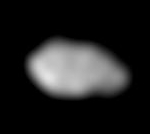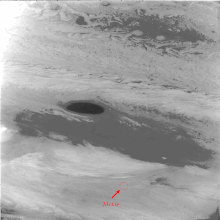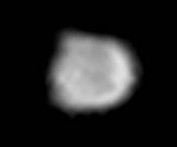Metis (moon)
 Image taken by Galileo's Solid State Imager between November 1996 and June 1997 | |
| Discovery | |
|---|---|
| Discovered by | S. Synnott |
| Discovery date | 4 March 1979 |
| Designations | |
| Pronunciation | /ˈmiːtəs/[1] |
Named after | Μήτις Mētis |
| Adjectives | Metidian, Metidean /mɛˈtɪdiən/ |
| Orbital characteristics | |
| Periapsis | 127974 km[a] |
| Apoapsis | 128026 km[a] |
Mean orbit radius | 128000 km (1.792 RJ)[2][3] |
| Eccentricity | 0.0002[2][3] |
| 0.294780 d (7 h, 4.5 min)[2][3] | |
Average orbital speed | 31.501 km/s[a] |
| Inclination | 0.06° (to Jupiter's equator)[2][3] |
| Satellite of | Jupiter |
| Physical characteristics[4] | |
| Dimensions | 60 km × 40 km × 34 km |
| 21.5±2.0 km | |
| ≈ 6200 km2[a] | |
| Volume | ≈ 42700 km3[a] |
| Mass | ≥6.4×1016 kg[a] |
Mean density | ≥1.5 g/cm3 |
| ≥0.8 cm/s2 (average) | |
| synchronous | |
| zero | |
| Albedo | 0.061±0.003[5] |
| Temperature | ≈ 123 K |
Metis /ˈmiːtəs/, also known as Jupiter XVI, is the innermost known moon of Jupiter. It was discovered in 1979 in images taken by Voyager 1, and was named in 1983 after the Titaness Metis, the first wife of Zeus and the mother of Athena. Additional observations made between early 1996 and September 2003 by the Galileo spacecraft allowed its surface to be imaged.
Metis is tidally locked to Jupiter, and its shape is strongly asymmetrical, with the largest diameter being almost twice as large as the smallest one. It is also one of the two moons known to orbit Jupiter in less than the length of Jupiter's day, the other being Adrastea. It orbits within the main ring of Jupiter, and is thought to be a major contributor of ring material.
Discovery and observations
[edit]
Metis was discovered in 1979 by Stephen P. Synnott in images taken by the Voyager 1 probe and was provisionally designated as S/1979 J 3.[6][7] In 1983, it was officially named after the mythological Metis, a Titaness who was the first wife of Zeus (the Greek equivalent of Jupiter) who between her and Zeus bore a daughter Athena.[8] The photographs taken by Voyager 1 showed Metis only as a dot, and hence knowledge about Metis was very limited until the arrival of the Galileo spacecraft. Galileo imaged almost all of the surface of Metis and put constraints on its composition by 1998.[4]
Although the Juno orbiter, which arrived at Jupiter in 2016, has a camera called JunoCam, it is almost entirely focused on observations of Jupiter itself. During close observations of Jupiter, it may capture some distant images of the innermost moons Metis and Adrastea.[9]
Physical characteristics
[edit]
Metis has an irregular shape and measures 60 km × 40 km × 34 km across, which makes it the second smallest of the four inner satellites of Jupiter.[4] Therefore, a very rough estimate of its surface area could be placed between 5,800 and 11,600 square kilometers (approx. 8,700).[citation needed] The bulk composition and mass of Metis are not known, but it is likely that its mean density is 1.5 g/cm3 or higher,[10] and its mass can therefore be estimated as ~6.4×1016 kg or higher.
The surface of Metis is heavily cratered, dark, and appears to be reddish in color[failed verification]. There is a substantial asymmetry between the leading and trailing hemispheres: the leading hemisphere is 1.3 times brighter than the trailing one. The asymmetry is probably caused by the higher velocity and frequency of impacts on the leading hemisphere, which excavates a bright material (presumably ice) from its interior.[5]
Orbit and rotation
[edit]Metis is the innermost of Jupiter's four small inner moons. It orbits Jupiter at a distance of ~128,000 km (1.79 Jupiter radii) within Jupiter's main ring. Metis's orbit has very small eccentricity (~0.0002) and inclination (~ 0.06°) relative to the equator of Jupiter.[2][3]
Due to tidal locking, Metis rotates synchronously with its orbital period (about 7 hours), with its longest axis aligned towards Jupiter.[3][4] Jupiter casts a shadow on all of Metis for 68 minutes each Metian day.[a]
Metis lies inside Jupiter's synchronous orbit radius (as does Adrastea), and as a result, tidal forces slowly cause its orbit to decay. If its density is similar to Amalthea's, Metis's orbit lies within the fluid Roche limit; however, because it has not broken up, it must lie outside its rigid Roche limit.[3]
Relationship with Jupiter's rings
[edit]
Metis's orbit lies ~1,000 km within the main ring of Jupiter. It orbits within a ~500 km wide "gap" or "notch" in the ring.[3][11] The gap is clearly somehow related to the moon but the origin of this connection has not been established. Metis supplies a significant part of the main ring's dust.[12] This material appears to consist primarily of material that is ejected from the surfaces of Jupiter's four small inner satellites by meteorite impacts. It is easy for the impact ejecta to be lost from the satellites into space because the satellites' surfaces lie fairly close to the edge of their Roche spheres due to their low density.[3]
See also
[edit]Notes
[edit]References
[edit]Citations
[edit]- ^ Noah Webster (188). A Practical Dictionary of the English Language.
- ^ a b c d e Evans Porco et al. 2002.
- ^ a b c d e f g h i Burns Simonelli et al. 2004.
- ^ a b c d Thomas Burns et al. 1998.
- ^ a b Simonelli Rossier et al. 2000.
- ^ IAUC 3507.
- ^ Synnott 1981.
- ^ IAUC 3872.
- ^ Hansen, C. J.; Orton, G. S. (2015). "JunoCam: Science and Outreach Opportunities with Juno". AGU Fall Meeting Abstracts. 2015: P41B–2066. Bibcode:2015AGUFM.P41B2066H.
- ^ Anderson Johnson et al. 2005.
- ^ Ockert-Bell Burns et al. 1999.
- ^ Burns Showalter et al. 1999.
Sources
[edit]- Anderson, J. D.; Johnson, T. V.; Schubert, G.; Asmar, S.; Jacobson, R. A.; Johnston, D.; Lau, E. L.; Lewis, G.; Moore, W. B.; Taylor, A.; Thomas, P. C.; Weinwurm, G. (27 May 2005). "Amalthea's Density is Less Than That of Water". Science. 308 (5726): 1291–1293. Bibcode:2005Sci...308.1291A. doi:10.1126/science.1110422. PMID 15919987. S2CID 924257.
- Burns, Joseph A.; Showalter, Mark R.; Hamilton, Douglas P.; Nicholson, Philip D.; de Pater, Imke; Ockert-Bell, Maureen E.; Thomas, Peter C. (14 May 1999). "The Formation of Jupiter's Faint Rings" (PDF). Science. 284 (5417): 1146–1150. Bibcode:1999Sci...284.1146B. doi:10.1126/science.284.5417.1146. PMID 10325220. S2CID 21272762. Archived from the original (PDF) on 5 December 2020.
- Burns, Joseph A.; Simonelli, Damon P.; Showalter, Mark R.; Hamilton, Douglas P.; Porco, Carolyn C.; Throop, Henry; Esposito, Larry W. (2004). "Jupiter's Ring-Moon System" (PDF). In Bagenal, Fran; Dowling, Timothy E.; McKinnon, William B. (eds.). Jupiter: The Planet, Satellites and Magnetosphere. Cambridge University Press. pp. 241–262. Bibcode:2004jpsm.book..241B. ISBN 978-0-521-81808-7.
- Evans, M. W.; Porco, C. C.; Hamilton, D. P. (September 2002). "The Orbits of Metis and Adrastea: The Origin and Significance of their Inclinations". Bulletin of the American Astronomical Society. 34: 883. Bibcode:2002DPS....34.2403E.
- Marsden, Brian G. (August 26, 1980). "Satellites of Jupiter". IAU Circular. 3507. Retrieved 2012-03-28. (discovery)
- Marsden, Brian G. (September 30, 1983). "Satellites of Jupiter and Saturn". IAU Circular. 3872. Retrieved 2012-03-28. (naming the moon)
- Ockert-Bell, M. E.; Burns, J. A.; Daubar, I. J.; Thomas, P. C.; Veverka, J.; Belton, M. J. S.; Klaasen, K. P. (1 April 1999). "The Structure of Jupiter's Ring System as Revealed by the Galileo Imaging Experiment". Icarus. 138 (2): 188–213. Bibcode:1999Icar..138..188O. doi:10.1006/icar.1998.6072.
- Simonelli, D. P.; Rossier, L.; Thomas, P. C.; Veverka, J.; Burns, J. A.; Belton, M. J. S. (October 2000). "Leading/Trailing Albedo Asymmetries of Thebe, Amalthea, and Metis". Icarus. 147 (2): 353–365. Bibcode:2000Icar..147..353S. doi:10.1006/icar.2000.6474.
- Synnott, S. P. (19 June 1981). "1979J3: Discovery of a Previously Unknown Satellite of Jupiter". Science. 212 (4501): 1392. Bibcode:1981Sci...212.1392S. doi:10.1126/science.212.4501.1392. ISSN 0036-8075. PMID 17746259.
- Thomas, P. C.; Burns, J. A.; Rossier, L.; Simonelli, D.; Veverka, J.; Chapman, C. R.; Klaasen, K.; Johnson, T. V.; Belton, M. J. S.; Galileo Solid State Imaging Team (September 1998). "The Small Inner Satellites of Jupiter". Icarus. 135 (1): 360–371. Bibcode:1998Icar..135..360T. doi:10.1006/icar.1998.5976.
External links
[edit]
